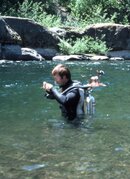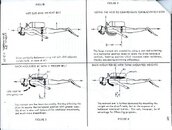Rich,
No, actually in the early 1960s the vest design evolved into the Fenzy vest, which some feel was the first commercially-available buoyancy compensator. In the early 1970s these evolved into the vests by Scubapro, Nemrod, Seatec etc. Very shortly thereafter the Stabilizer Jacket was developed by Scubapro.
In January 2006 David McLean put together a PowerPoint presentation on the history of buoyancy compensation.
Bill Herder, owner of Deep Sea Bill's in Newport, Oregon came out with an interesting design where the BC was the back of his custom wet suits, and I had two built for me. The first was an inverted "U" shape glued into the wet suit, but then he decided a sandwich design where the whole back of the wet suit was the BC worked better, so he re-did my wet suit to make that concept. (See the photo below, the white portion of my wet suit is Bill's sandwich BC.)
I gave a talk at the IQ-6, or Sixth International Conference on Underwater Education October 4-6, 1974 in San Diego, CA where I talked about the advantages and disadvantages of various strategies for buoyancy compensation. The diagram below comes from that talk, titled "The Life Vest."
I came out with a modified vest that I called the Para-Sea BC, but was never able to get anyone interested in producing it (early 1980s).
The first BCD was probably described by Tom Mount in his book, Safe Cave Diving, published by The National Association for Cave Divers in 1971. In it I believe (from memory) that he described using two chlorox bottles tied together with the rope under the arms for buoyancy compensation in caves.
SeaRat
No, actually in the early 1960s the vest design evolved into the Fenzy vest, which some feel was the first commercially-available buoyancy compensator. In the early 1970s these evolved into the vests by Scubapro, Nemrod, Seatec etc. Very shortly thereafter the Stabilizer Jacket was developed by Scubapro.
In January 2006 David McLean put together a PowerPoint presentation on the history of buoyancy compensation.
Bill Herder, owner of Deep Sea Bill's in Newport, Oregon came out with an interesting design where the BC was the back of his custom wet suits, and I had two built for me. The first was an inverted "U" shape glued into the wet suit, but then he decided a sandwich design where the whole back of the wet suit was the BC worked better, so he re-did my wet suit to make that concept. (See the photo below, the white portion of my wet suit is Bill's sandwich BC.)
I gave a talk at the IQ-6, or Sixth International Conference on Underwater Education October 4-6, 1974 in San Diego, CA where I talked about the advantages and disadvantages of various strategies for buoyancy compensation. The diagram below comes from that talk, titled "The Life Vest."
I came out with a modified vest that I called the Para-Sea BC, but was never able to get anyone interested in producing it (early 1980s).
The first BCD was probably described by Tom Mount in his book, Safe Cave Diving, published by The National Association for Cave Divers in 1971. In it I believe (from memory) that he described using two chlorox bottles tied together with the rope under the arms for buoyancy compensation in caves.
SeaRat





